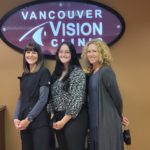
Three members of Dr. Patel’s staff: Morgan, a technician, Miranda, an optician, and Trisha, who works at the reception desk. Dr. Patel says that the training strategies he has used has resulted in much better patient care and greater profitability.
By Raj Patel, OD, FAAO
Oct. 26, 2022
Your staff is on the front lines, the first people patients talk to on the phone and the first faces they see when they walk into your office. Here are a few staff training strategies that made a significant difference to how well our team is able to give patients a positive experience and help us grow profitability.
Our staff training efforts have paid off, as we are consistently at 69 percent established patients and 31 percent new, along with sustained revenue growth (4-7 percent) annually over the last 10 years.
“Tell them where we are going, and keep telling them”
How do you get employees in a practice that started in 1952 to remember where we are headed? By revisiting our practice vision. For over 20 years our vision has been “to be all things eye within our community.” This has meant that we should be able to take care of most eye problems most of the time within the scope of our six providers and our years of experience.
The challenge is that, like most practices, we get caught in the day-to-day work, in the trenches, and often forget to look up to see where we are going. Newer staff members may not be fully aware of the many services your practice provides. Teaching is the best way for them to know what you do and why you do it.
Talking to your staff at meetings about how their work helps support your mission will give them a sense of how they fit into the greater goals of the practice.
For example, our front desk worked in a patient at the end of the day as we were getting ready to close the door. An older man in our neighborhood fell off his ladder an hour earlier and came in because he was not seeing well out of one eye. We stayed late, saw him, determined that he needed an immediate referral due to a large vitreous hemorrhage and we coordinated it. It ended well for him.
At the next staff meeting, I made a point of praising the reception team member who was closing the door and chose to welcome this patient and get him seen. This was a shining moment of remembering our mission of “being all things eye for our community” — and it meant a lot to the staffer that she made a difference for that gentleman.
The more the staff understands the practice mission, the more they say “yes” when we have inbound calls of “do you provide pediatric care, do you fit scleral contacts, Ortho-K, see diabetic patients, take metal out of eyes, etc.?” Recently, we hired a new staff member and she did not know what our mission was. I had failed at letting her know we are “all things eye to our community.” She took a call and referred that call to another office because she thought we only provided eye exams for contact lenses and glasses to adults.
Epic fail in on-boarding and explaining the mission. When we keep those calls, they turn into patients who receive the care they need via medical appointments, which creates trust and eventually turns into a comprehensive exam and glasses sale.
Think about how you want your community to view your office, and consider starting there in determining what your mission is. Then think about how to illustrate to staff how your mission plays out in their day-to-day work.
Other Articles to Explore
“Be the BEST part of our patients’ day”
Many years ago we worked with our staff to answer the question, “If our practice had a tombstone, what would you want it to say?” In other words, what would you like our patients to say about their experience with us?” We used that exercise to help everyone understand that if this is how we wanted to our patients to perceive us, then this is who we need to be.
Then, 8-10 years ago, I read the book “Start with Why” by Simon Sinek. This changed my mindset around the idea of a mission statement. We realized that what we really wanted was to “Be the BEST part of our patients’ day.” Period. We could do that by focusing on two things: being positive and uplifting to each other and treating our patients in the same way.
We then started identifying rough spots in the patient transaction and working to develop ways to lower those friction points so the patient would have a smooth, time-efficient visit that was positive. Now when we ask our team members what we do or what our mission is, everyone can easily recall our mission to be the best part of our patients’ day.
Being the best part of our patients’ day has little to do with clinical care, but so much to do with how we make people feel. High fives, laughs, connecting on places to travel, great restaurants, pets, all the things that make us feel noticed, can make a difference in how the patient feels when they leave. And you never know, maybe they are having a hard day with their teenager, or work stress, and your office can make a difference in how they feel for the rest of the day.
What kind of trickle-down impact does that have? Think of the opposite, when someone upsets you (cuts you off when driving, poor service interaction at the store). Sometimes we stew over that and the next person we talk to (often our family or friends) ends up being the punching bag. So, finding a way to be the brightest spot in someone’s day can have a significant positive downstream impact.
An important second part of being the best part of our patients’ day was making sure we have systems in place that help us save time and avoid the misunderstanding of fees. We all know that the most common reason patients leave our practices is not clinical care. It’s typically that someone on the staff created a poor experience or they did not understand their bill. So, reducing those two hurdles was our focus.
In understanding the bill, it comes down to our process of explaining screening retinal imaging, contact-lens evaluation fees at the inbound call, new fitting fees in the exam room, overages on product purchase at the time of selection and having a solid grasp of medical benefits /deductables /co-pays when scheduling visual fields, OCT and medical visits. We review the language we should use in talking about these things and where in the patient journey all of this should be explained. We don’t want the patient to get to the “stage” (reception desk) and have loud misunderstandings about their fees.
It increases staff confidence to rarely have patients get to check out and not have a clear understanding of their fees. It also helps them feel more confident when working with patients knowing that we will be running on time, and that when patients get to the check-out desk, they will have had a positive experience and be in a good mood.
CONtinually EXecute The BAsics (CONEXTBA)
Eight to 10 years ago, we started breaking down every major point in the patient journey (inbound call or text, parking, walking into building, reception area, bathrooms, greeting by staff, tech interaction, doctor time, hand off to contact-lens tech or optician, check out, etc). We had the entire team think about what is important to the patient/what do they see and feel at those points in the journey. We had them go into the parking lot, walk through the doors, sit on our couches, see the forms we use, on and on.
From that exercise, we made lists of the three basic things we need to execute consistently each part of the patient’s journey. In the end, we used that list of three things from each step of the journey for us to focus on as a team. I felt that if we can just do the basics well, every time, we should have many wins. Wins on time, teammates feeling confident that the person who handled the patient before them did a good job, and that the patient can move through their visit in a timely way.
We call this process CONtinually EXecute The BAsics (CONEXTBA ). We had fun at staff meetings over the first few months of starting CONEXTBA and said this is the island we live on. We made a CONEXTBA flag and printed it on paper and taped it on monitors that team members saw. It started to become a visual of not getting caught in the weeds of detail, but to focus on the few things in their portion of the patient journey that, together when everyone in our office does same, makes for a great patient experience.
Spending time at least a few times a year going over the basics (just three things per point in the patient journey) helps everyone understand their role. This also helps new staff members see the big picture of how their work impacts the patient journey.

Raj Patel, OD, FAAO, Diplomate, American Board of Optometry, is a partner with Vancouver Vision Clinic, which has two locations in Vancouver, Wash. The practice is one of CooperVision’s Best Practices. To contact him: raj.patel@vancouvervision.com

























